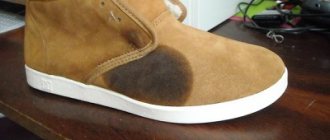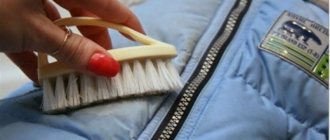Ink stains on clothes appear from careless movement of the hand with a ballpoint pen, when the paste has flowed in a pocket due to the heat, after children's creativity, or from liquid dye spilled out of clumsiness. The situation looks depressing, but not catastrophic if you know how to remove the ink. After all, even an old trace can be removed.
To achieve the result, you can use special chemicals or improvised means. The main thing is not to delay and take into account the type of material.
Precautionary measures
Before starting to remove ink, it is recommended to prepare the contaminated surface by soaking it by immersing the problem area in cool water for 15-20 minutes. A loose stain will be easier to remove. If there is no water, wiping with a damp cloth containing alcohol will help.
General rules for removing ink:
- It is better to act immediately, without waiting for it to dry.
- There is no need to wipe the stain with a napkin, but only gently blot it so as not to smear it on the surface and prevent it from penetrating into the fibers.
- Avoid exposure to heat: do not blow dry or immerse in hot water, otherwise it will be difficult to remove from clothing.
- If delicate or colored fabrics are soiled, you should test the seams or hems on the reverse side so as not to spoil the item.
- It is not recommended to wash and dry clothes until the stain is completely removed.
- Fresh ink should be immediately blotted with a damp cloth or paper on both sides to remove excess ink from the fabric and prevent it from being absorbed.
- They begin to remove blots from the edge, gradually moving towards the center.
- If the stain is large and diffuse, then treating the fabric with paraffin or wax will help limit further spread. They need to be melted to a liquid state and applied along the contour of the stain with a cotton swab. When the substance saturates the material and hardens, they begin to remove the ink.
Important! You need to work with ammonia, vinegar and other aggressive substances in a ventilated area or in the open air.
Removing ink stains is carried out on a flat surface, for example, on a table, with a white cotton cloth on the wrong side.
Regardless of the type of product used, after treatment, the area of contamination should be thoroughly rinsed with water, and then washed with detergent.
The best compositions for stains
NameprosMinusesPrice, rubRating positionsVANISH OXI ACTION (3L) Works well on fresh stains; Safe composition for the skin; Smells nice. High cost. 879Dr. Beckmann (250 ml) Works on all types of stains; Cleans in cool water; Convenient use due to the presence of a brush. Does not work well on old stains; Small volume. 209 Wide Haiter, oxygen (600 ml) Suitable for cleaning old and fresh dirt; Cleans ink in cold water; The composition is safe for fabrics. High price. 539 Bon with active oxygen (300 g) Lack of hazardous substances and chlorine; Low price; Universal use. Cannot be combined with laundry detergents. 289SODASAN, gel concentrate (200 ml) Developed based on natural substances; Economical consumption; High efficiency; There is a sponge brush. The bottle has a small volume; High cost.302 The best products for baby clothesUmka (400 g) Efficiency; Low price; Convenient dosage. Dries the skin; The composition contains sulfates.55DOMAX, BABY CARE (500ml) Does not cause allergies; Convenient use thanks to the dispenser; Safe composition. High price. 282 Stain removers - pencilsSNOWTER (35g) Efficiency; Ease of use; Low price. Quickly consumed. 51MEINE LIEBE, for children's underwear (35 g) Easy to use; Suitable for cleaning various stains.Crumbles when applied; Fast consumption.189Removal with alcohol
Alcohol successfully removes ink stains, marks from a ballpoint pen or marker on cotton fabrics. You need to apply a few drops to a fresh mark or rub it with a cloth soaked in alcohol. After 3-5 minutes the surface should be clean.
- To remove dry and old prints, dilute with vinegar 1:1 and wipe the fabric until all traces of the substance disappear.
- A composition of alcohol and soda (1:2) is effective. Cover the blot with it and carefully blot the pigment with a napkin.
- It is also used with glycerin for dresses made of colored fabrics, so as not to disturb the richness of the shades. A solution is prepared from 5 measures of alcohol and 2 measures of glycerin. The ingredients are mixed and the stain is wetted. You need to wait a while until the ink traces disappear.
Important! Alcohol should not be used on wool, silk, viscose or acetate fabrics.
Ink specifics
Before you wash off the ink, you need to understand its specifics. The substances that make up ink, regardless of their scope of application, have a number of properties. These include:
- color saturation;
- pigment durability;
- penetration and drying speed;
- water resistance;
- light fastness.
Blots remain in their original form for a long time. An old stain is almost impossible to clean, so urgent action is necessary. After all, it is much easier to wipe it off immediately without allowing it to dry out.
Ink is used not only in pens, but also in seals, stamps and cartridges. The variety determines its composition. For example, cheap ballpoint pens contain low quality dyes. It will be quite easy to wash off traces of them. An expensive fountain pen is already filled with high-quality paste, which is thoroughly eaten away. It will be very difficult to wash it off.
Particularly difficult are traces of gel pen ink. They are created using a water-based gel, but oil-based gels are also available. The consistency of a gel-like substance is more viscous and viscous. It is particularly durable, caustic and can easily spread across fabric.
Black cartridges use pigment ink, while color inkjet cartridges use water-based ink. It’s easy to wipe off traces of them.
After studying the characteristics of stains, you can think about how to remove ink from fabric.
Citric acid or lemon
Lemon juice can dissolve ink. It is squeezed onto the contaminated area of the fabric and held for 20 minutes. In case of severe damage, repeat the procedure 2-3 times.
Use lemon juice to clean outerwear, and add a pinch of salt to enhance the effect.
It is also used with baby powder or talcum powder. Sprinkle the powder tightly onto the stain, and squeeze lemon on top to moisten the surface. The composition is carefully rubbed in with your fingers and left for an hour.
Lemon juice can completely replace a concentrated solution of citric acid.
Advice! Milk can help remove an ink stain on a shirt. The tissue in this place is immersed in milk for 15-20 minutes.
Helpful information
Tips for removing pens from different surfaces:
- The older the stain, the more aggressive the composition should be to remove it. When washing things, a stain remover must be added to the powder.
- When trying to remove a fresh stain, the cleaner should be applied to a cotton swab or napkin, and not to the dirty surface itself. Old pen marks are soaked completely.
- Gel pens lend themselves well to removal with fatty solutions, such as oil or cream. However, such compositions cannot be used on fabrics.
Ammonia
Ammonia can be used in several combinations to remove ink stains.
- Mix ammonia and baking soda in equal parts. It is enough to take a teaspoon of each of the components. Apply the mixture to the damaged area and leave for 2-3 hours.
- To clean dense materials, ammonia is combined 1:1 with medical alcohol.
- On colored fabrics, ink stains are removed with a mixture of ammonia and turpentine from the same amount of components. After treatment, rinse and wash clothes.
Advice! Glycerin from your home medicine cabinet works well with ink. Moisten the stain with the mixture and leave for 1 hour. Use salted water for rinsing, and laundry soap for washing.
Basic Rules
Do not wet or rub ink marks. They tend to blur and penetrate deeper into the fibers.
If drops from the pen shaft get on the fabric, immediately add absorbent material - baby powder, talc, starch or powdered chalk. They also apply a piece of paper towel or napkin. You can take soft rags and toilet paper.
Clean laundry after washing
Then, to remove ink marks from the prepared fabric, a cleaning agent selected for the type of textile is used. This can be a professional stain remover or a composition prepared independently at home.
When processing, it is important to wipe off streaks towards the center to prevent the contamination from increasing in size.
After applying the cleaning mixture to the stains, wait the specified time and wash off the remaining residue with a stream of cool water. The product should then be washed as usual.
Vinegar
Acetic acid will help if ink gets on carpet or other fleecy surface. It needs to be warmed up a little before use. Then moisten a cotton swab and treat the stain. Then wipe it with wine alcohol, which will help preserve the color of the pile. Finally, the cleaned area is washed with a solution of water with a few drops of ammonia.
Baking soda
How to remove pen ink from your favorite thing? To start, try using regular baking soda. This substance, which can be found in any kitchen, quickly and safely removes ink stains. How to use it:
- Dilute baking soda with water to make a thick paste.
- Distribute the mixture over the surface of the fabric.
- Leave the paste on the stain until completely dry.
- Rinse off the product with cool running water.
Repeat the procedure if necessary. After removing the stain, be sure to wash the product with added detergent or powder.
Hairspray, for removing from leatherette or leather
To combat ink on leather and leatherette products, you will need an alcohol-based varnish. The clothes are laid out on the surface, placing a clean cloth napkin under the area with the blot. Spray the varnish generously from a distance of 30 cm and wait 3-5 minutes for the reaction. Wipe gently without waiting for it to dry. The stain will be noticeably reduced. To achieve the result, repeat the procedure.
Advice! Hairspray is suitable for removing ink from synthetic fabrics.
Laundry soap
When thinking about how to remove ink, try using this simple but effective remedy. How to use it:
- Lather damp skin with a bar of laundry soap.
- Scrub your hands lightly with a soft clothes brush. Do not use pumice stones under any circumstances to avoid damaging your skin.
- Rinse the foam off your hands and apply nourishing cream to your skin.
Repeat the procedure if necessary. Remember that ink is absorbed more strongly when exposed to hot water. Therefore, use cold liquid to wash stains.
What to do with leather products
Leather is a delicate material and requires careful handling. There are several ways to clear it of ink:
- For a light jacket, a mixture of soda with ammonia or glycerin with ammonia is suitable. After treatment, wipe the surface with a dry cloth.
- Use a rich cosmetic cream for your hands or face. Apply it to the stained area and leave for 5-10 minutes. Remove residues with a cotton pad and wipe the surface with a damp cloth.
- Sprinkle a fresh stain on the sofa with salt and leave it there for a couple of days. Then it is cleaned off with a brush, and the skin is wiped with turpentine using a swab.
- Strokes with a ballpoint pen will remove the tape. It is glued to the skin and pressed. All that remains is to rip it off with a sharp movement.
What not to do?
When starting to remove the paste, you need to remember a number of prohibitions, neglect of which can harm the material:
There is no need to rush to wash out the mark, since the ink does not dissolve with ordinary water. In addition, there is a risk that the stain will spread and become even larger.- You cannot rub fresh dirt with a dry or wet cloth for the same reason.
- There is no need to try to scrape off the stain with a sharp object - the ink is quickly absorbed into the fibers, so chemical rather than mechanical action is most effective.
Jeans
Traces of ink on denim are not immediately noticeable. The stained area is first treated with alcohol or a preparation based on it. Then cover it with salt for several hours. If cleanliness has been restored, then wash the clothes.
To remove ink stains, you should use one of the proven methods:
- After treating the jeans with alcohol, drip hydrogen peroxide on top. Wash off the composition after 15 minutes and wash the area with laundry soap.
- Warm lemon juice will help save your jeans. After heating, it penetrates deeper into the material and lightens the blot.
- White and light blue trousers are treated with a mixture of equal parts of peroxide and ammonia.
- Cover a fresh stain with starch, blot it with a sponge, and then clean it.
Advice! For red pigment it is better to use ammonia, and for black or purple pigment it is better to use diluted acetone.
Tomato
Another effective way to remove ink from a printer or pen is tomato juice. The acids in this vegetable quickly and safely remove ink marks without harming the skin. How to remove dirt:
- Squeeze a few drops of tomato juice onto a sponge.
- Dry your skin for 1-2 minutes.
- Rinse your hands under running water.
Repeat this procedure until the coloring pigment completely disappears from the skin.
How to remove dried stains
- Kerosene, which is suitable for cleaning woolen fabrics. It is applied to the contaminated area, left for 5-10 minutes and washed off with warm water.
- The following method is suitable for all types of materials. Combine glycerin with dishwashing gel in a 3:1 ratio. Moisten the napkin with the composition and wipe the stain from the wrong side, and then from the front. If the stain remains stubborn, apply a little more glycerin and rub in with your finger. Wait 5-10 minutes and wash.
- An effective remedy for old stains is white vinegar. If the ink is not removed after trying, it is recommended to immerse the item in a solution of white vinegar and water (1:1) for 30 minutes. During the soaking process, blot the stain with a napkin 3 times.
Advice! Colored dye removes the whiteness from white fabric. The product is diluted in water and the clothes are soaked for 2 hours.
- Baking soda can be used on all types of fabrics. It is necessary to prepare a paste by mixing the powder with water in a ratio of 2:1. Apply the resulting paste to the ink blot using a cotton swab. Remove the remains with a napkin.
- Under the influence of alcohol and nail polish remover, the stain will definitely lighten. A mixture of equal parts of the components is applied to the dirty area and left for 5-10 minutes. Blot with a cotton swab.
- Any stain remover marked Oxi can remove ink from a blouse, because it contains oxygen-containing bleaches that can penetrate the pores of the fabric. Use medications according to the instructions on the package.
- Antipyatin stain remover, thanks to active oxygen, cleans fabric from ink prints. It is applied to the stain and left to act for 10-15 minutes. Rinse with warm water. re-process if necessary.
It is better to dry-clean expensive items immediately and not take risks. They will also help you in case of unsuccessful attempts to remove the ink yourself.
Industrial products
From ink traces you can select effective ready-made chemical varieties. Use any stain remover after the excess dye has been absorbed by an absorber or paper napkin. Then check the effect of the product by distributing it in a small amount from the inside out.
After making sure that the composition is safe, they begin cleansing. It is recommended to cover the fabric around the perimeter of the stain with a thin layer of salt or starch. These substances are designed to prevent further spread of ink. Then apply the composition with a cotton pad, wipe the marks and leave for the time specified in the instructions.
Popular brands:
- Vanish. Used against a variety of pollutants. Suitable for white and colored textiles.
- Sano. There is a more gentle effect on the fibers.
- Amway. It is considered a safe product that is used even for children's things.
- White. Recommended for white cotton types.
- Antipyatin. Allows you to effectively remove ink, but only immediately after it appears on clothes.
Ink stains on clothes can be cleaned if an effective technique is applied in a timely manner. It is important to choose the right product that does not deform the fibers or change the color of the product.
Recommendations for cleaning different types of fabric
A pen stain may end up on your favorite trousers, a stylish sweater or a light T-shirt. In order not to spoil the item, when cleaning you must take into account the type of fabric . The wrong cleaner can corrode light-colored fabric or ruin its shade.
| Textile | What will help remove ink? | What can't be used? |
| Suede | Stiff brush, stationery eraser, special suede cleaner | Strong chemicals and solvents |
| Leather | Table salt | Strong chemical solvents |
| Linen | Hairspray, alcohol, vinegar solution | Chlorine |
| Synthetic fabric | Vinegar, glycerin | Products containing acetone |
| Chintz | Vinegar, branded stain removers, alcohol | Aggressive stain removers in large quantities |
| Cotton | Hairspray, acetone, alcohol, hydrogen peroxide | Chlorine |
| Silk | Milk, kefir, glycerin | Acetone, acetic acid |
| Wool | Milk, glycerin | Acetone, chemical solvents |
If you have doubts about the type of fabric, it is better to have the item dry cleaned by professionals. You can learn how to wash a pen from a white shirt here.











